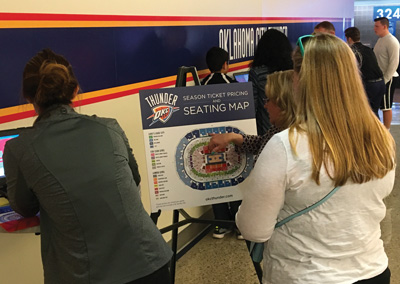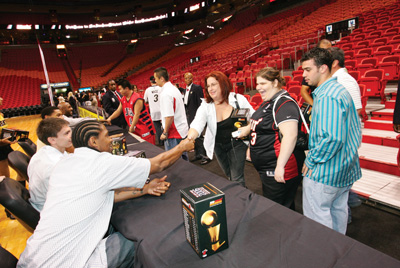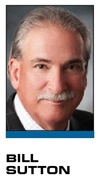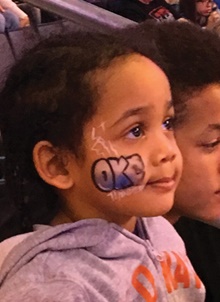For some time, I have told clients, students and whoever else might listen, “Just because you could, doesn’t mean that you should.”
I saw this axiom in action several weeks ago when I visited the Oklahoma City Thunder while I was in town for a conference. As the team was hosting me at its game that evening, I offered to take Thunder execs Scott Loft and Brian Byrnes out to lunch. They accepted and suggested that prior to going to lunch I should stop by and see their TRUE (Thunder Relocation and Upgrade Event). I did, and I was shocked by the number of people who had opted to attend in person rather than complete the process online — especially for a team that would renew more than 96 percent, so seat upgrades and add-ons would be limited, if they were available at all.
Loft told me that the Thunder views opportunities for touch points and being able to come face to face with its customers as points of differentiation for its organization and opportunities to visit with stakeholders. Loft said that it was not uncommon for these stakeholders to bring their family and in some cases take a half-day of vacation from work to be there.
 |
For the Thunder, the annual relocation and upgrade event is another chance to show fans that the organization values them.
Photo by: BILL SUTTON (2)
|
The Thunder is not averse to technology and uses beacons, online preference centers, mobile apps and so forth. The team just wants to capitalize on as many personal interactions as possible.
In an era when high-tech implies you can do almost anything wherever you like on your own terms and without human interaction, high-touch seems dated. No need for bank tellers, you can bank online; snail mail — why bother? But is an email thank you as impactful and treasured as a handwritten note? Then it
would follow that meeting with a representative of the Thunder, being behind the scenes and having the opportunity to ask questions and engage in a conversation about the team, is more meaningful than an email stating your window for going online and viewing seat options.
Loft also mentioned something called The Oklahoma Standard. Having gone to school and lived in Oklahoma for nine years, I understood immediately what he meant. The Oklahoma Standard (and I believe there are variations that pertain to different markets throughout the United States) means understanding what is important to the people in your market; understanding, sharing and demonstrating that you accept their values; and showing your intentions and integrity by being transparent and consistent.
Every Thunder game is preceded by a prayer, and during the national anthem every hat is off. This is Oklahoma, where people are the greatest natural resource and why the 1995 bombing of the Alfred P. Murrah Federal Building was so appalling and galvanizing. There really aren’t no-shows, as every game is valuable and an investment, particularly in a state where dollars are much tighter now that the price of oil has declined so sharply.
People in Oklahoma like to visit and enjoy opportunities for social interactions. The Thunder provides that as well as a unifier for fans of the two major colleges whose rivalry is called Bedlam. It is the Thunder that positions Oklahoma City as a major league city, just as it is for the Jazz in Salt Lake City, the Kings in Sacramento, the Spurs in San Antonio and the Packers in Green Bay. It elevates those cities to a position of equal footing in the sports world with New York, Chicago and Los Angeles. It is a source of pride in place. But while the cities can be said to be comparable, the lifestyles and values remain unique and distinct. Therefore, the marketing and sales activities can also be unique, a type of geo-situational marketing.
In a single-team market, there may be less competition and less opportunity for other sport entertainment options, but that lack of competition may also exacerbate the intensity of that interest and connectivity to the one team, necessitating more opportunities for interaction and communication throughout the year. Because it is more important to the consumer, it must therefore be more important to the provider to find meaningful ways to make that happen.
Gestures, more so than words, have become the emotional currency between the organization, the fan and the team. Thus, in Oklahoma City, the gesture of being available to assist with renewals and offering tours of the building and refreshments is conveying that fans are important and that the team knows this is an important decision for them. The Thunder is happy to create an entire week when helping fans renew and pick seats is the No. 1 priority for the organization. The message is clear: You are important, and we value you and your business.
 |
Miami Heat season-ticket holders got their own championship trophies, presented by players.
Photo by: MIAMI HEAT
|
In 2006, after winning its first NBA title, the Miami Heat, in a multifranchise market and a major city, demonstrated the importance of the gesture concept. Each season-ticket holder and sponsor, and other individuals identified as important to the Heat, received a championship trophy replica from the Heat organization. While this alone would be a significant gesture, it didn’t stop there. The Heat created a private event where the season-ticket holders, sponsors and other VIPs were presented the replica trophy by the Heat players in a gesture that conveyed not only their appreciation for their support, but also implied, “You were a part of this championship.”
As I realize more and more every day, we live in a world where consumers have the ultimate power because of the freedom of choices and delivery systems available to them. That availability dictates whether we attend or watch at home, whether we buy locally or buy via Amazon or some other provider. As an organization, we can only hope to influence these decisions by providing meaningful forms of communication that resonate with the values and needs of the people in our markets.
Bill Sutton (wsutton1@usf.edu) is the founding director of the sport and entertainment business management MBA at the University of South Florida and principal of Bill Sutton & Associates. Follow him on Twitter @Sutton_ImpactU.







